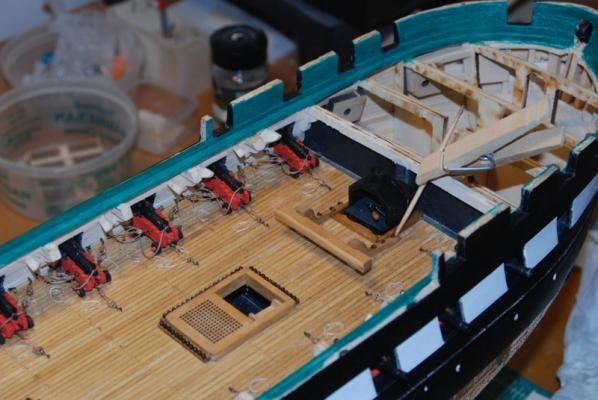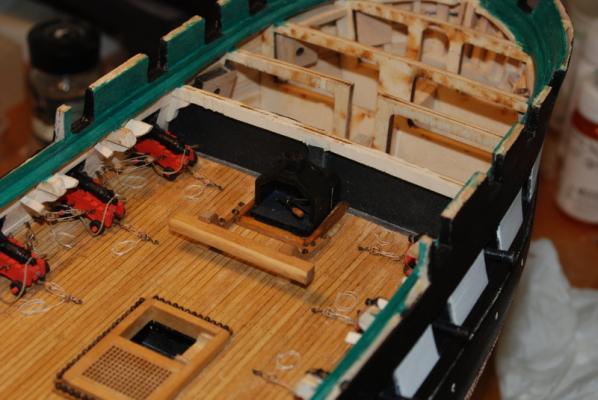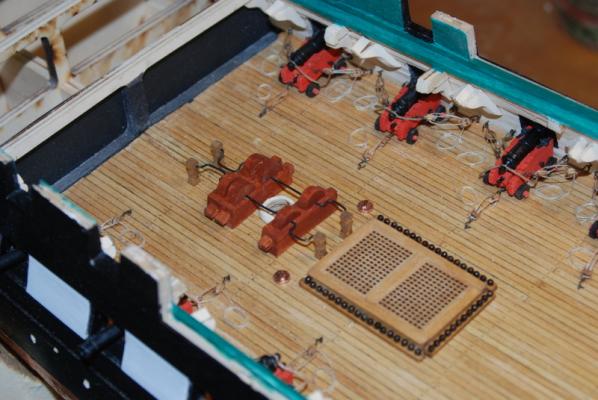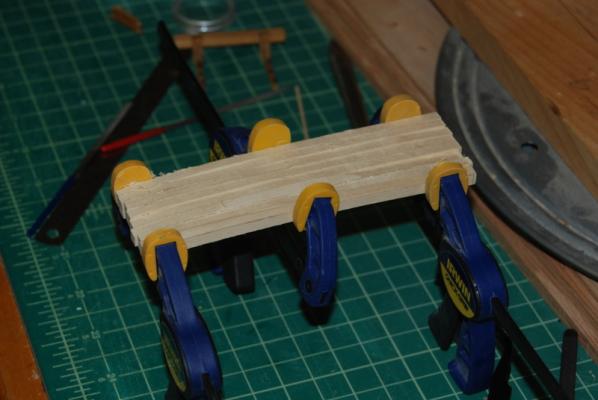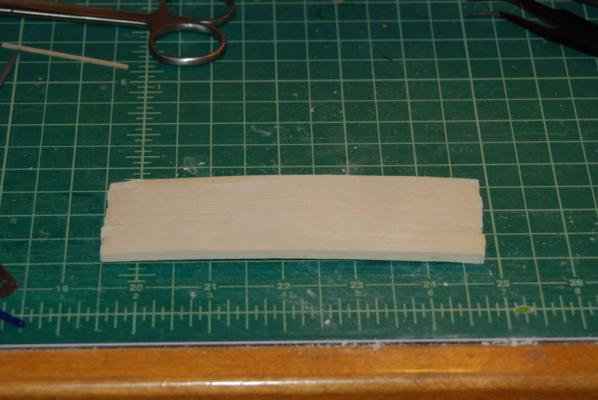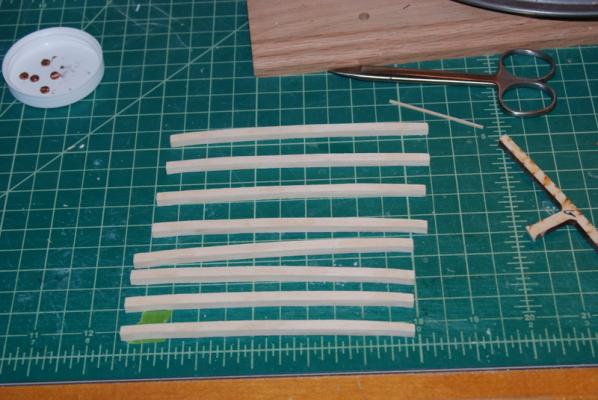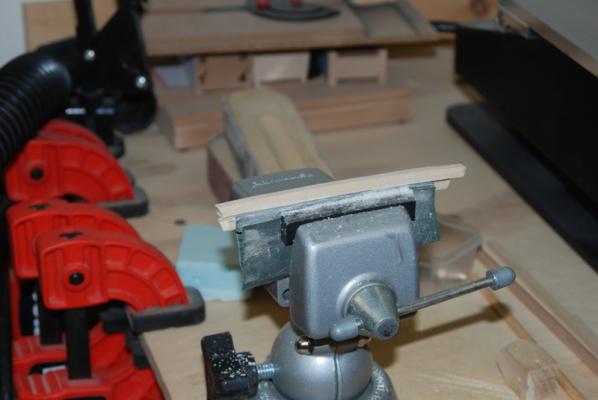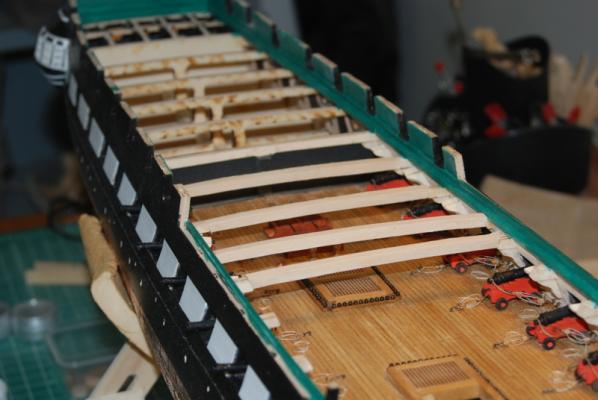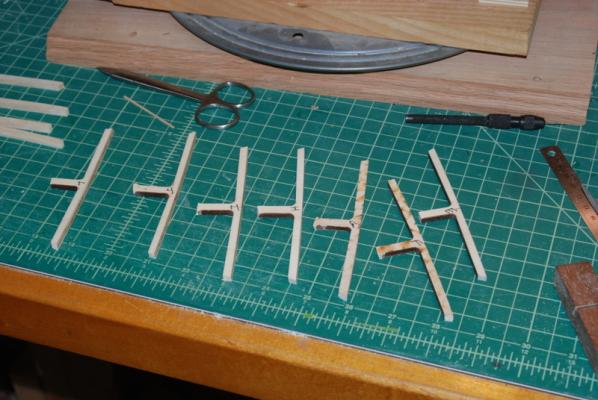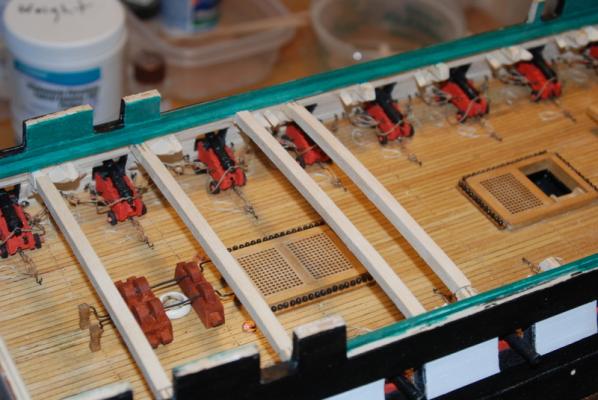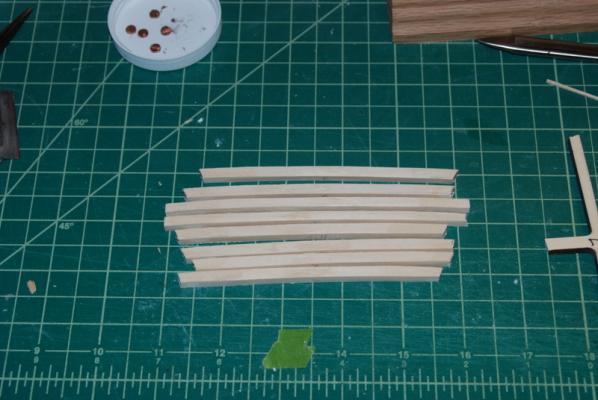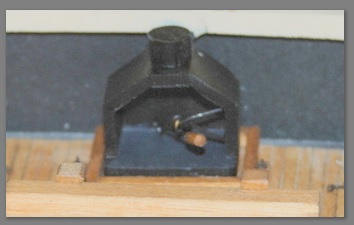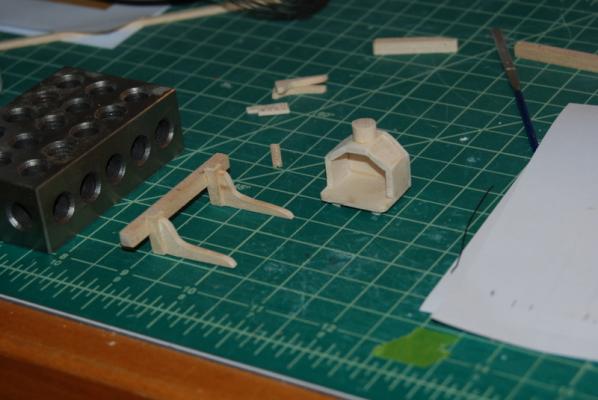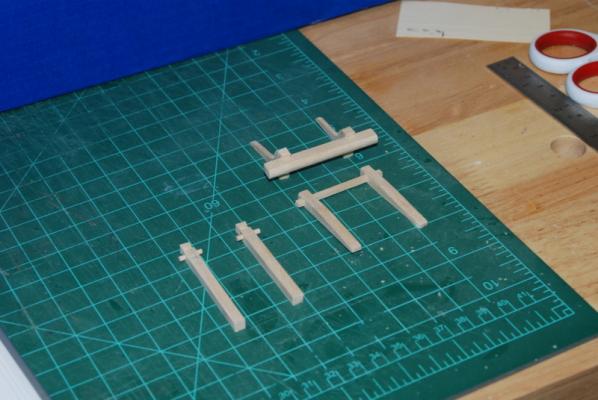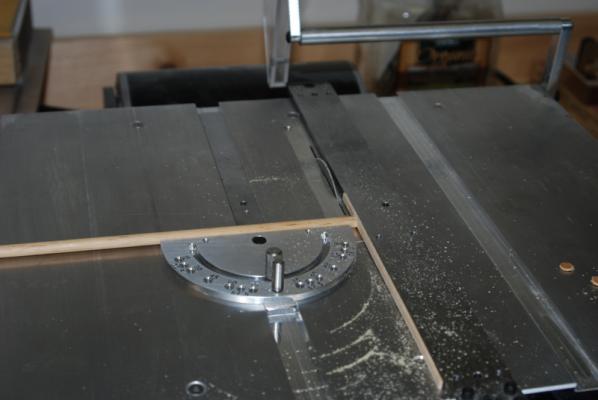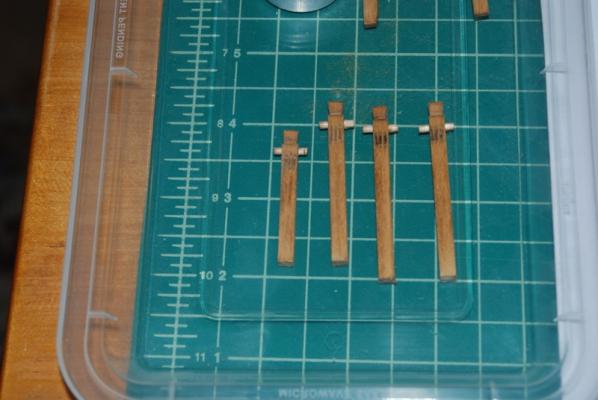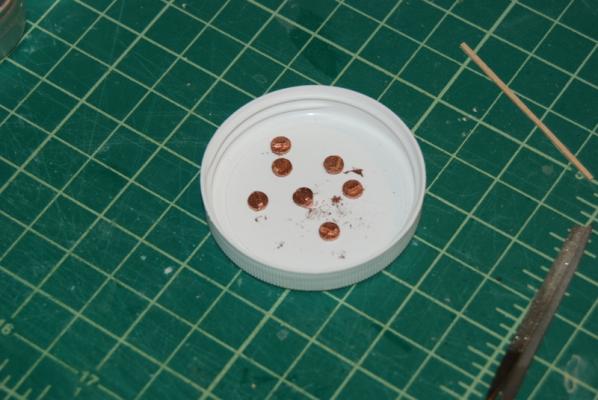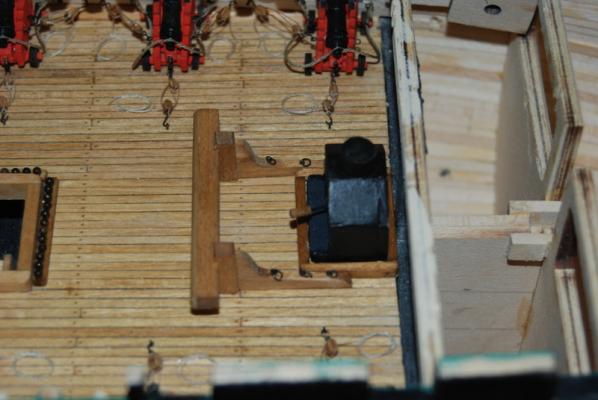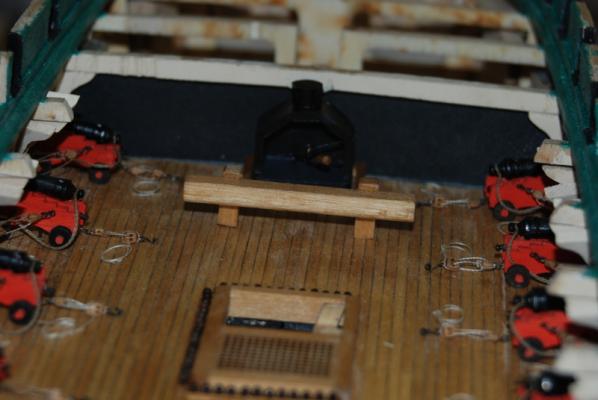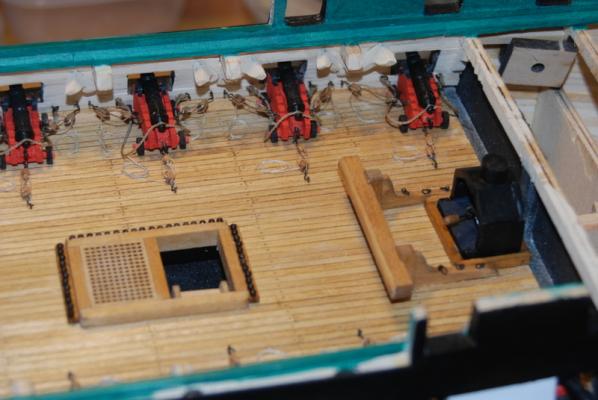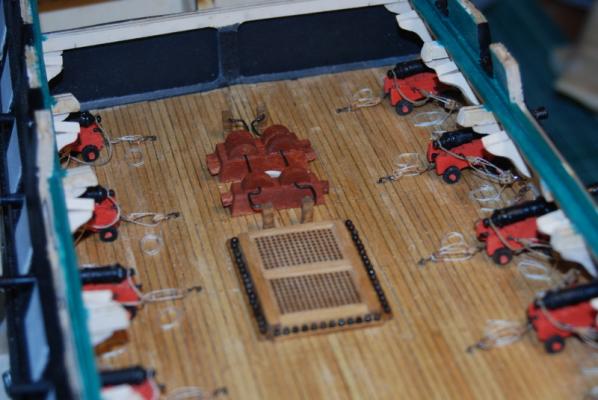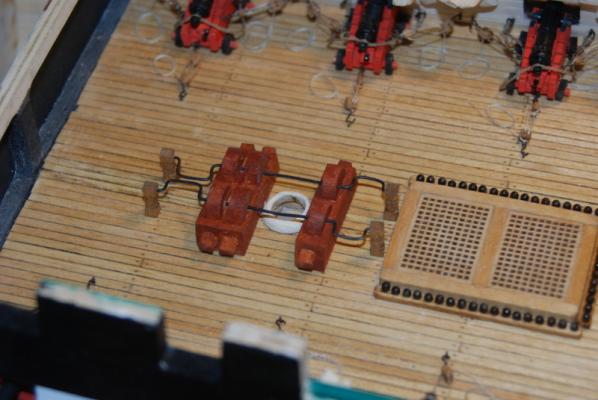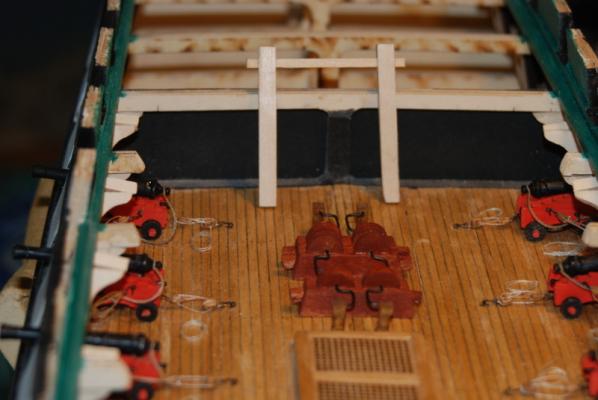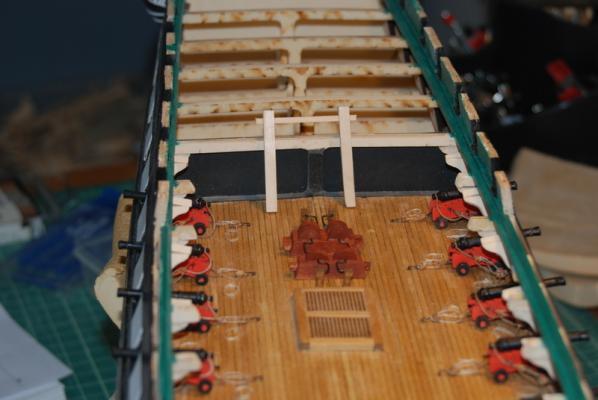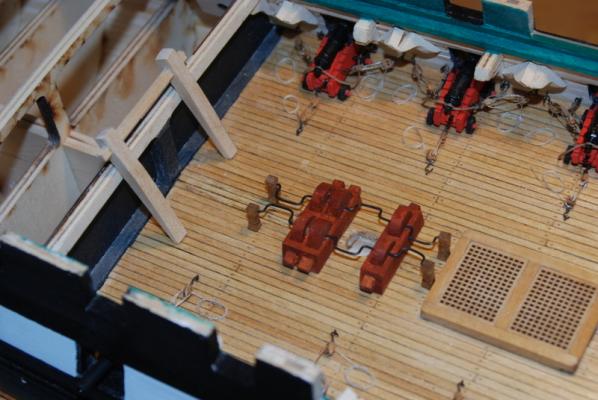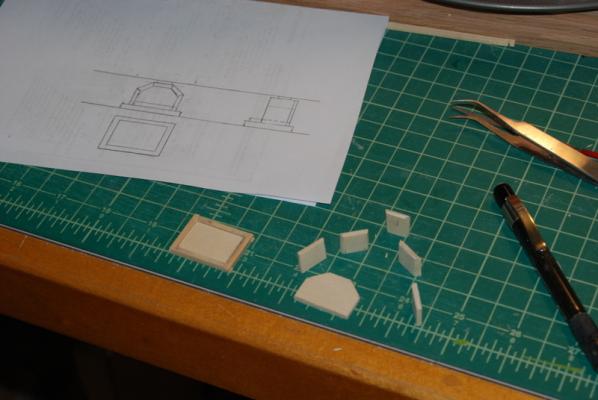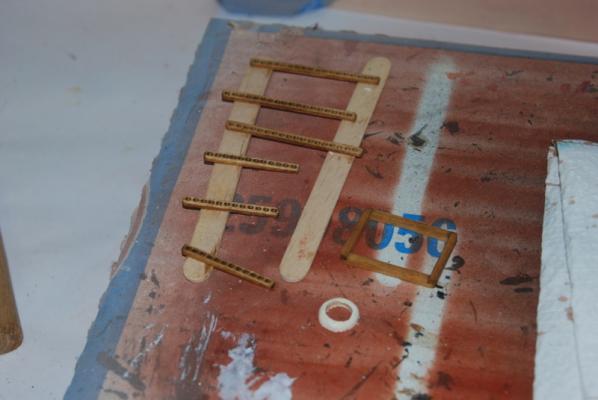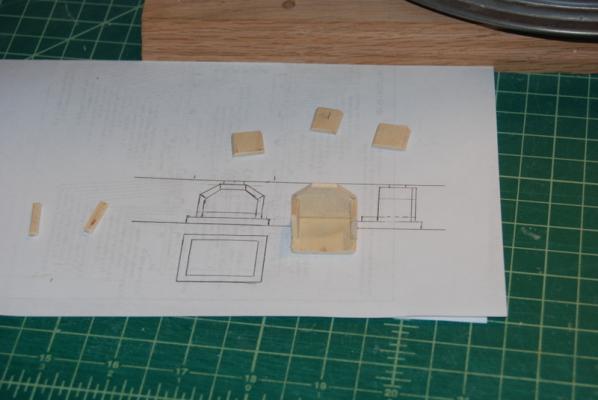-
Posts
2,409 -
Joined
-
Last visited
Content Type
Profiles
Forums
Gallery
Events
Everything posted by usedtosail
-
Thanks Boyd and Sal. Your Bounty and Syren builds, respectively, are coming together very nicely. Thanks George. I am going to plank around both sides of the main hatch, but leave the hatch open except for the skid beams inside. I am going to have the launch being towed behind when I mount it, so you will be able to see the gun deck through the main hatch. That's my plan for now anyway.
- 1,350 replies
-
- constitution
- model shipways
-
(and 1 more)
Tagged with:
-
Thanks Steve and George, and for the likes, too. I finished up the gun deck last night, for real this time, unless I mess it up with the work going on above it. I made new coaming sides for the bigger stove, stained them and glued them in. I added more to the front of the stove, painted it black and glued it into the coaming, them glued the riding bitts back in. One side of the bitts kept coming up from the deck, so I came up with an on the spot clamping technique that worked a treat. So here is the new stove arrangement with the chimney the right distance from the fore mast, so the spar deck hatch will be in the right place. And for completeness, the pump area with the ammo scuttle covers in place. I then started on the spar deck beams that will go over this whole area. My first attempt was to cut out a single beam, using the old beams that I cut out over a year ago as a template. I traced it onto a piece of 3/16" basswood sheet, then cut it out with the scroll saw. I sanded the top to final shape, then attempted to use the thickness sander to get the underside to its final shape. I found that because the piece is curved, any little movement up and down caused the thickness to change, so it was coming out too thin is places. I decided that since i just got the thickness sander I am going to need more practice with flat strips before I attempt curved ones. So plan B was to roughly cut out all the beams on the scroll saw and lightly glue them together side by side. When that was dry, I sanded the tops together using the belt sander, and the undersides using a large sanding disk in the drill press. I then soaked the block in alcohol for about an hour and separated the beams. On a couple I had to wedge an X-Acto knife blade into the ends to get them started. As you can see, they were still a little rough. I then cut them to length, using the old beams as templates. Here are the old beams, and the beam extensions that I left on the bulwarks to hold up the new beams. I cut these a little long so I could sand them into a good fit. I don't want to have to do a lot of sanding of the beams once they are in place because I don't know how to keep the dust from getting onto the gun deck, so I am trying to fair them as much as possible off the model before attaching them. I still did not like the way the undersides looked, so I took some sandpaper and placed it on top of one of the old beams and clamped them into a vice, then sanded the underside of each beam. This worked pretty well and the beams looked much better. The next picture has a new beam on top of the sandpaper being sanded. Here are some of the beams in place before I sanded the ends. Still more work to do but they are getting there.
- 1,350 replies
-
- constitution
- model shipways
-
(and 1 more)
Tagged with:
-
That is terrific looking deck framing. Great job.
- 255 replies
-
- granado
- bomb ketch
-
(and 2 more)
Tagged with:
-
- 1,350 replies
-
- constitution
- model shipways
-
(and 1 more)
Tagged with:
-
Here are some pictures of the progress so far on the gun deck. I thought I was almost done, but read on... I made up the stove, aft riding bitts, and main topsail sheet bitts. There were all finished with oak stain. As you can see, one is cut off a little short, so I made two more so I have the fore bitts too. I drilled six holes for the simulated sieves and connected them with an awl. They are only 3/16" wide so too small for me anyway, to make from thin layers. I also made up the ammo scupper covers, using slices of dowel that I cut with the Byrnes saw. I added a small strip across the top, which is used to open them on the real ship, and painted them with Testers Brass enamel paint. I have to say that these metal colored paints like the gold and brass really cover nicely, as opposed from the ME brass paint that doesn't cover well at all. I added the pot holder to the stove using some black wire and a bent eyebolt as a hook. Here are pictures with the riding bitt, stove and coaming in place. The problem is that the stove is too far forward for the chinmey to line up with the hatch and stove pipe on the spar deck, so I am going to remove them, remake the coaming, and add a box to the front of the stove. It would have good to check this BEFORE I made them, and certainly before I glued them in place! Sheech... You can also see the cannon ball racks in place with the cannon balls. Here are pictures of the updated pumps with a straight wire between the pumps around the main mast. After I clean up the stove situation next week, I will be started to make the new deck beams. I kept the old beam sections that I cut off over a year ago and will use them as templates for the new beams. I am going to be cutting these from basswood sheet, and will shape them up in the new thickness sander I got for my birthday. I can't wait to play with that new toy. Have a great weekend, all.
- 1,350 replies
-
- constitution
- model shipways
-
(and 1 more)
Tagged with:
-

Brig Eagle by robnbill - 1:48
usedtosail replied to robnbill's topic in - Build logs for subjects built 1801 - 1850
That is looking great Bill. I think you have achieved a good balance with what you are leaving open. -
I have been working on finishing up the gun deck details, and will have pictures soon. Thanks to Jay (Modeler12) I am adding the ammo scuttle covers, which are not quite done yet. I also am finishing up the stove and did some work on the main mast base, after making a tenon in the large dowel supplied for the main mast. I figured I better be able to fit this in place now before adding the spar deck beams and loosing the access to this area. I was going to make a bigger main mast coat for this deck, but there is not enough room between the pumps for one much bigger. I did replace the two handles between the pumps with straight wire because with the mast in place, there would not have been enough room between the handles and the mast. I finished the belaying pin plan and it looks like I will be good with 11 pins on the U shaped rail, as shown on the plan, and not have to add pins to the monkey rail at the main mast. Also, six pins in the spider rail around the mizzen mast will be OK. This is all because there are enough belaying pins on racks on the bulwarks to take the lines I will need to rig, with some to spare. of course once I get into the actual rigging this may change, but I am not going to worry about that now. The next thing I need to do is finalize the standing rigging lines I need to rig, then figure out what sizes of line to use for each of standing and running lines. Then I will figure out how each of the lines will be run and how many blocks I will need of each type and size. All of this can be done as a background task while I am still working on the deck furniture and bow rails, but will need to be done before I start building the masts and spars.
- 1,350 replies
-
- constitution
- model shipways
-
(and 1 more)
Tagged with:
-
Very nice build Dan. I learned a lot from your techniques, especially the sails and flag.
- 241 replies
-
- queen annes revenge
- pirate
-
(and 2 more)
Tagged with:
-
Thanks Jay. So I will add them to both decks then.
- 572 replies
-
- constitution
- frigate
-
(and 1 more)
Tagged with:
-
Nice info on the barrels and ammo scuttles. Do you think those scuttles have always been in the spar deck or could they have been added in later refits of the Constitution?
- 572 replies
-
- constitution
- frigate
-
(and 1 more)
Tagged with:
-
Yeah George I do too. But, this will be about it for the gun deck. I am now thinking of leaving the ships boat off the hatch beams and show it along side the ship, so more of the gun deck can be seen. Maybe towed behind if that doesn't make the case even bigger than it needs to be now. We shall see...
- 1,350 replies
-
- constitution
- model shipways
-
(and 1 more)
Tagged with:
-
As promised, here is an update on the small amount of work I have done in the last week or so. Firstly, I finished and installed the chain pumps on the gun deck. I made some supports for the ends of the pump handles using my little lathe. I am not sure how the ends would have been supported but this worked for me. I made the handles by bending some 28 gauge wire. In these pictures you can also see the monkey rail for the spar deck, which I have extended down into the gun deck for strength. This required square holes in the two uprights for the horizontal piece to slide into. I used a smaller drill then some small square files to enlarge the holes until the bar fit. As you can see it is a pretty tight fit around the main mast. But, I wanted to add a mast coat around the main mast hole, so I made one on the lathe. Again, I am not sure if there would be one on the gun deck. I also made some racks to hold cannon balls to go around the two hatches. I drilled holes in some strip wood using the XY table on the drill press and will fill them with the stainless steel ball bearings I blackened previously. Here is the mast coat being painted and the cannon ball racks being stained. Also in that picture is a coaming for the stove. I realized where I had ended the gun deck section in the front covers about 75% of the stove, so I decided to add a low res version of the stove so there would be something black there if it could be seen. I am using this picture of the current stove as a guide. Here are the stove pieces being assembled. I am only about half way done with the stove itself, but should have it done by the end of the week. I will probably add the pot holder too, just for fun. Outside of the workshop I am also working on the belaying pin plan. With my desire to use the U shaped rail and the monkey rail, I will not have as many belaying pins around the main mast as shown on the kit plans, by less than half. The Revell kit has belaying pins in the monkey rail, but the plans on the CD don't show holes for them and getting good holes through the bar seems a bit hard. So, I am going through an alternate belaying pin plan I found in the NRG Shop Notes II for the Constitution which shows less pins around the main mast. Also, I am planning only to show the three topsails on the finished model, which means I can eliminate the buntlines and leechlines for the other sails, which cuts down the number of pins I will need. I also will not be showing bowlines for any sails. I am still in the process of getting the final pins counts. I was also worried that I would not have as many pins on the bulwarks since I removed the bulwarks in the waist, but that doesn't seem to be the case. I think I will be OK with the 11 pins shown on the U shaped rail or maybe just need to add 1 or 2 more pins to that rail. I'll let you all know when I have it figured out. Thanks again for watching.
- 1,350 replies
-
- constitution
- model shipways
-
(and 1 more)
Tagged with:
-
Very nice work on the beams. I am coming to the point where I have to make a few beams for the Connie, so this is a very timely tutorial. Thanks.
- 456 replies
-
- finished
- bomb ketch
-
(and 2 more)
Tagged with:
-
Oh, and thanks for the information Buick Nut. I just recently saw the President plans in one of Chappel's books, which is pretty compelling evidence for six windows across the transom, but it was easier for me to just make 5.
- 1,350 replies
-
- constitution
- model shipways
-
(and 1 more)
Tagged with:
-
Thanks Boyd. I was hesitant about starting a build log because I still feel so new to this, too, but I really enjoy it now. I love that it is helping other builders like yourself, but I learned a lot from other build logs too, and still do. I have to say, your Bounty is coming along really nicely and I am going to be following along with your log because I can learn from you too. Your interior details are just amazing. For the rest, I should have an update tomorrow. I have been doing some work but have not had time to get the pictures off the camera.
- 1,350 replies
-
- constitution
- model shipways
-
(and 1 more)
Tagged with:
-
Captain, I am glad my pictures can be of help. You are on the same track I was - many redos, reusing pieces of parts and adding new wood to them, etc. In the end, I liked the result and yours looks like they will do nicely. So far, I think this was the hardest part of the build, so hang in there and you will be through to more fun stuff.
-
Popeye, that is some magnificent work. I love the color scheme and the details you have added. Well done, sir.
- 956 replies
-
- andrea gail
- trawler
-
(and 1 more)
Tagged with:
-
Jeff - Thanks for looking in and all the likes. I'd say your Fair American is more than fair, although you can't fair too much on these ships . All of the planking is butt jointed on mine, so no overlaps. I am not sure I have seen overlapping planking before. The strip chooses the ship! - I love it! George is right - it is finding small enough balls for the cannon balls that is the issue. Ball bearings work great, especially stainless steel. And Bill's method of heating the balls before blackening works great, which is the method I used.
- 1,350 replies
-
- constitution
- model shipways
-
(and 1 more)
Tagged with:
-
Hi George. Here is another link you might find useful, if you haven't already seen it : http://www.captainsclerk.info/ The Navy used to have the contents of the Constitution CD on a web page, but it seems to have been taken down.
- 1,350 replies
-
- constitution
- model shipways
-
(and 1 more)
Tagged with:
-
Glad to be of help Jeff. Those clips really do come in handy. I just had a look at your Fair American build. You are off to a great start.
- 1,350 replies
-
- constitution
- model shipways
-
(and 1 more)
Tagged with:
-
You will. Maybe the stuff on the CD will help you decide.
- 1,350 replies
-
- constitution
- model shipways
-
(and 1 more)
Tagged with:
-
Your welcome George, There is some pretty interesting stuff included. Its fun to poke around on it.
- 1,350 replies
-
- constitution
- model shipways
-
(and 1 more)
Tagged with:
-
Thanks George. The CD can be bought from the US Navy museam store web site - http://museumstore.navyhistory.org/CD-Constitution-Plans-p/618.htmor the Constituion museam web site - http://store.ussconstitutionmuseum.org/products/uss-constitution-plans-for-model-ship-builders-and-general-researchers.
- 1,350 replies
-
- constitution
- model shipways
-
(and 1 more)
Tagged with:
About us
Modelshipworld - Advancing Ship Modeling through Research
SSL Secured
Your security is important for us so this Website is SSL-Secured
NRG Mailing Address
Nautical Research Guild
237 South Lincoln Street
Westmont IL, 60559-1917
Model Ship World ® and the MSW logo are Registered Trademarks, and belong to the Nautical Research Guild (United States Patent and Trademark Office: No. 6,929,264 & No. 6,929,274, registered Dec. 20, 2022)
Helpful Links
About the NRG
If you enjoy building ship models that are historically accurate as well as beautiful, then The Nautical Research Guild (NRG) is just right for you.
The Guild is a non-profit educational organization whose mission is to “Advance Ship Modeling Through Research”. We provide support to our members in their efforts to raise the quality of their model ships.
The Nautical Research Guild has published our world-renowned quarterly magazine, The Nautical Research Journal, since 1955. The pages of the Journal are full of articles by accomplished ship modelers who show you how they create those exquisite details on their models, and by maritime historians who show you the correct details to build. The Journal is available in both print and digital editions. Go to the NRG web site (www.thenrg.org) to download a complimentary digital copy of the Journal. The NRG also publishes plan sets, books and compilations of back issues of the Journal and the former Ships in Scale and Model Ship Builder magazines.



